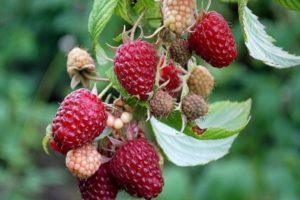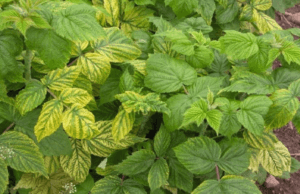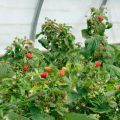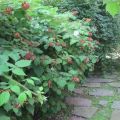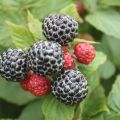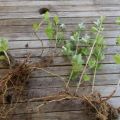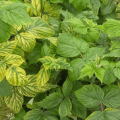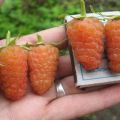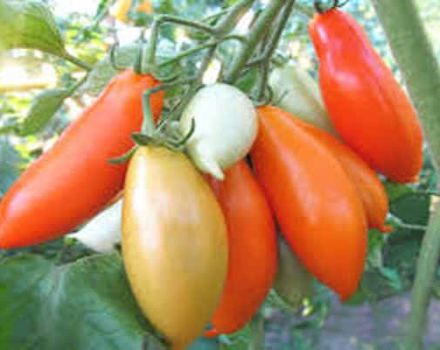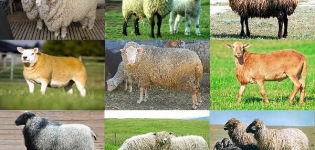How can you multiply raspberries quickly at home
Raspberries are grown on almost all household plots. How to propagate correctly in order to get the desired result, it is important to know such information for every gardener. When cultivating a raspberry bush, it is necessary to select planting material and properly grow seedlings.
When is the best time to propagate raspberries
Each gardener chooses: how to breed raspberries and the breeding season.
Comparative Breeding Chart by Season
| Season | Than | how |
| Spring | Offshoots, lateral branches | Undercut with horizontal part |
| Summer | Cuttings of young shoots | Cut close to the ground or with a slight depression |
| Fall | Cuttings of adult bushes | They are cut and stored in special conditions until spring |
Each method is described in more detail below.
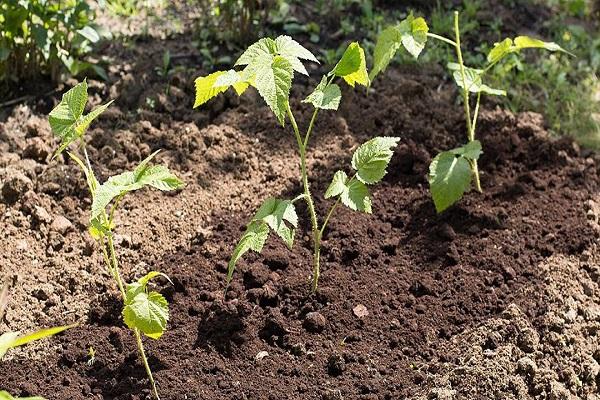
Spring
Spring breeding is less stressful than autumn breeding. In sunlight and warmth, the overgrowths, the layers take root easily, calmly tolerate the effects of the environment. Produced by lateral layering or scions. Formed at the internodes of the root part, located horizontally. Since these roots are at different depths, they appear unevenly throughout the season. There are many such layers and, if not needed, are removed.
If used for planting, it is necessary to cut off the layers with a sharp tool, plant in special soil. Drizzle liberally and cover with foil. When a green sprout appears, feed. Fruiting will begin next year.

Summer
For the propagation of raspberries by layering in the summer, young cuttings are used that did not have time to stiffen. They have an increased ability to form radicular formation.
Features of summer breeding:
- In green shoots there are fewer valuable substances than in ripe ones, respectively, storage of green material for a long time is impossible.
- It is characterized by a balance of forces: for the beginning of those that are in the handle; after - those that will form in young roots. Accordingly, it is necessary to do everything necessary for full growth until the strength runs out, otherwise the plant will die.
Reproduction in summer differs from spring in that green shoots are not dug out with a horizontal part, but are harvested by cutting off the ground or at some deepening (by 10 mm). Dip the lower end into the root stimulator. After 12 hours, the sprout is transferred to the ridge under the film.These micro-conditions are conducive to rooting.
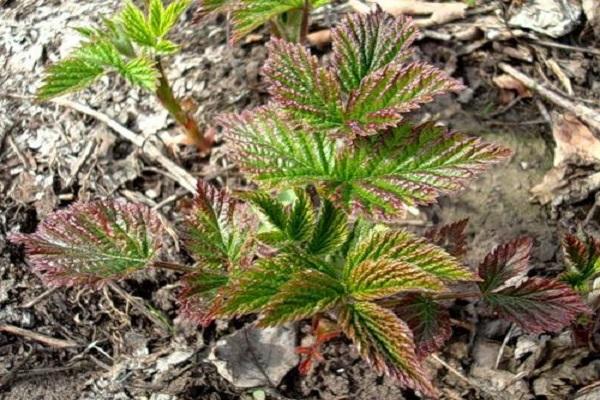
Fall
Harvesting cuttings in the fall is used for different varieties of raspberries. A 3-4 year old plant with strong shoots is used as a mother material. The optimal time for cutting cuttings is September, length - 25-30 cm, there must be 4 buds. The cut is carried out observing the angle 45about... Further storage is determined by climatic conditions:
- If the winter is not harsh and snowy, the temperature is not lower than -15 aboutC, the workpieces are stored in the ground at a depth of 0.8 m. They need to be wrapped in a cloth, placed in a container with sand. Extract when the ground thaws.
- If the soil freezes by more than a meter, the cuttings should be stored in the basement, placed in a container with sand.
- In spring, cut off the bottom edge by 10 mm, place in a solution with a growth stimulator for 12 hours.
- Plant in the ground, cover, creating a greenhouse effect.
- After rooting, plant it in the ground.
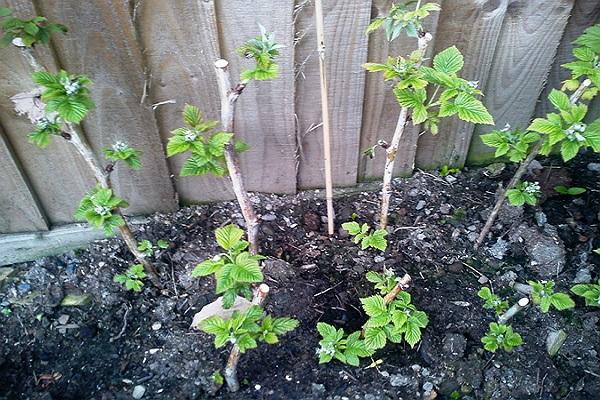
Preparatory work
Preparation consists in the selection of tools and planting material for accelerated reproduction.
What tools and materials will be needed
Depending on the breeding method, various auxiliary materials will be required. A sharp secateurs are required. If the cuttings are cut for winter storage, containers, sand, peat or sawdust are needed. If the seedling material is immediately planted, containers with fertile soil are needed, a covering film to create a greenhouse effect.
The process of harvesting planting material
Before harvesting the material, you need to select a grade. Raspberries are common, large-fruited, remontant, standard. Each has certain advantages. For example, the ordinary is a reliable variety that takes root in various conditions. The downside is low yield.
Attention is drawn to undemanding care, fruiting time, quality, size, taste characteristics of berries, and disease resistance.

Raspberry breeding methods
Reproduction is carried out in various ways, each of them has its own distinctive features.
Root offspring
The number of offspring in 5-year-old shrubs varies and depends on the type of plant.
Necessary actions:
- In the summer, mainly in the middle, separate the offspring from the root of the main plant along with a lump of soil.
- Plant in a nursery for adaptation or in a prepared place.
- Pour water into the hole, install a seedling, sprinkle with soil. In hot weather, they must be shaded and provided with watering.
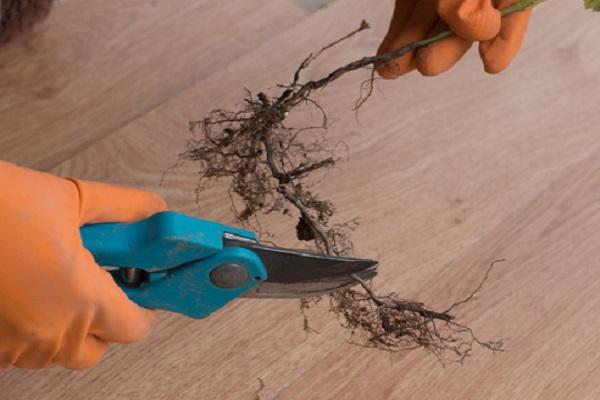
Root cuttings
Cutting is a convenient way. The cuttings are harvested by digging up the offspring. On the cuttings, cut the roots that have reached a thickness of 2 mm, without disturbing the lateral branches on them. After the cuttings, sort, taking into account the diameter, tie, put in containers, sprinkle with peat, sawdust, sand or use a mixture of them. After moisten the mixture, place the containers in the cold. Optimal temperature conditions up to +4 aboutC. Stored until spring.
The site for planting must be prepared in the fall: dig it up, clean it of weeds, fertilize with organic matter and complex fertilizers.
In the spring it is necessary:
- loosen the soil;
- level the surface;
- make shallow ditches (6-8 cm);
- lay the cuttings;
- sprinkle with soil;
- water, cover with foil (to create a microclimate).
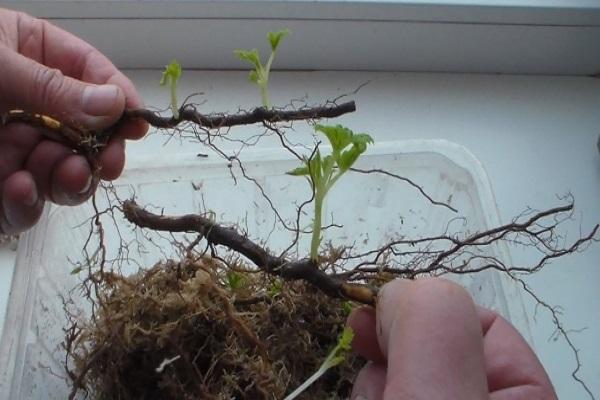
After the appearance of green shoots, remove the film, mulch the surface. Shoots should be protected from cold draft, direct sun.
During the season, the soil must be kept loosened and clean. Feed the sprouts as needed. Pay attention to preventive measures to combat insects and raspberry diseases.

Green cuttings
Raspberry propagation by green cuttings is carried out by root suckers. They appear on the roots of the plant after 2-3 years of cultivation.Shoots should be harvested in June (mostly in cloudy weather). Scheme of actions:
- choose with 2-3 leaves;
- cuttings should be cut at ground level or by deepening the secateurs a few centimeters, capturing the white part;
- in a shaded area, cut the shoots into cuttings 5-7 cm long;
- make bundles;
- immersed in a special solution with a growth stimulator, stand for 15 hours;
- plant in a mixture with peat;
- cover with a film;
- after 2 weeks, the formation of roots will begin, and after a month, the cuttings begin to grow;
- cut watering, periodically open the film, providing ventilation;
- sprouts should be planted in a greenhouse or on a ridge, providing shading.
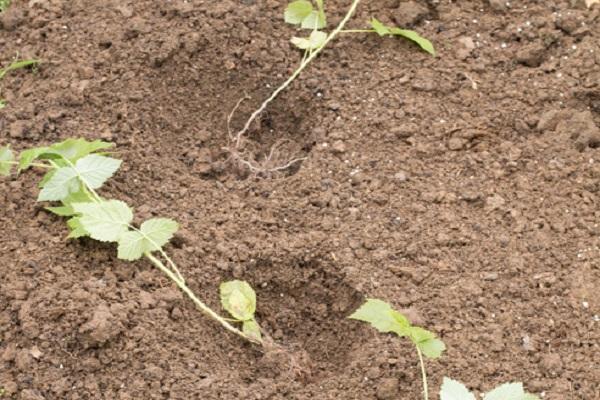
By dividing the bush
Growing in this way is rarely used. The division is used for the forced transplant of raspberries to a new place. It is produced in the spring before the buds swell or in the autumn, after the cessation of growth. It is necessary to dig a bush, divide it. Each sprout must have a complete root system. After planting, cut the shoots to a height of 0.3 m from ground level.
Woody offspring
It is easier to propagate by lignified offspring, which arise on the roots of the plant from the buds. It is important to choose high quality bush material. In early autumn, dig up lignified offspring of one year old. It is important to try to keep the maximum number of roots up to 0.15 m long. Examine offspring, remove damaged, sick, black, infected with insects.

Propagation of raspberries by seeds
Plants propagated by seeds retain varietal characteristics and quality. The seed method is used by breeders to breed new varietal species.
This requires:
- Collect seeds at the end of the season. Crush large ripe berries, add water. The good seed will settle, the bad will float.
- Dry the seeds.
- Sow after stratification. In December, place the seeds in a cloth bag, immerse them in wet sand or sawdust. Leave in cold conditions for 3 months.
- In early spring, sow into the ground, sprinkle lightly, cover with foil, leave warm. The inputs will appear at a temperature not lower than +20 aboutC. Periodically moisten the soil from a spray bottle.
- Seedlings need to be hardened, periodically opening the film, and exposed to the street in warm weather.
- When reaching 10 cm, plant the sprouts. Landing in the ground is done after a year.
Scottish breeding method for raspberries
The method was developed in Scotland, hence the name. Excellent for breeding remontant varieties. With this method, you can get a dozen seedlings from one cutting. One drawback: it takes more time, it will take 2.5 years before the first harvest appears.

It is necessary:
- Mulch the bush in the spring. This is a quick way of forming a large number of buds on the roots.
- In August or early autumn, cut the root cuttings. In winter, keep in a cellar, wrapped in wet moss.
- In the spring, place the cuttings in a warm place. Put in a container with peat or sand, pour over.
- They will sprout quickly. After 5-8 days, real raspberry leaves will appear.
- Using a sharp knife, cut off the green shoot from the root cuttings by touching the slightly yellow lower end (a small piece of the parent cuttings). It is on it that the roots will appear. Slicing is done every 2-3 days.
- Plant sprouts in nutritious soil and keep at a temperature not lower than +25 aboutFROM.
- After 6-8 days, plant the rooted seedlings in separate containers. Care as for seedlings: watering, fertilizing, loosening, hardening.
Lateral branches or offshoots
Raspberries 2 years old provide excellent planting material. In spring, twigs appear on the plant - layers that are used for plant propagation:
- select the branch on the north side;
- the offspring, without cutting off, bend to the soil, dig in a trench;
- the cuttings will take root and give a root;
- in the fall, divide the cuttings into seedlings;
- drop off at the right place.
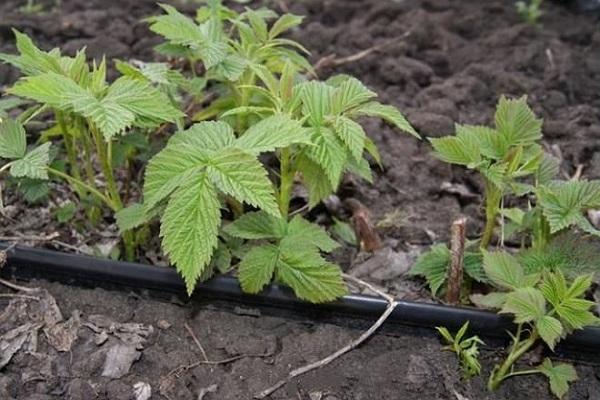
Care of planted cuttings
It is necessary to plant rooted cuttings, keeping a distance, 0.12-0.15 m will be enough. Daily watering and covering with foil are required. The first green shoots will appear in a month. Roots begin to grow and branch out.
It is necessary to remove the film for the day to harden the sprouts, cover at night in order to keep the seedlings from the cold. The frequency of watering is gradually decreasing. The soil should be moistened to a depth of 0.3 m. At the end of May, young seedlings are shortened by 0.1 m from above.
The soil needs to be loosened periodically to provide root aeration and prevent rotting. Transplant the rooted shoots to the prepared place. Weeding is carried out in order to prevent disease damage. Adaptation in sprouts will take place sooner if the garden bed is mulched with manure, humus, peat.
Breeding raspberries at home is easy. It is important to follow all the recommendations correctly.
